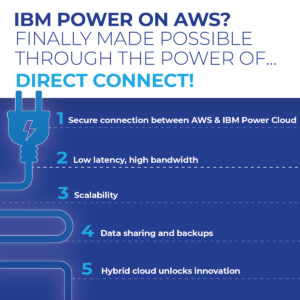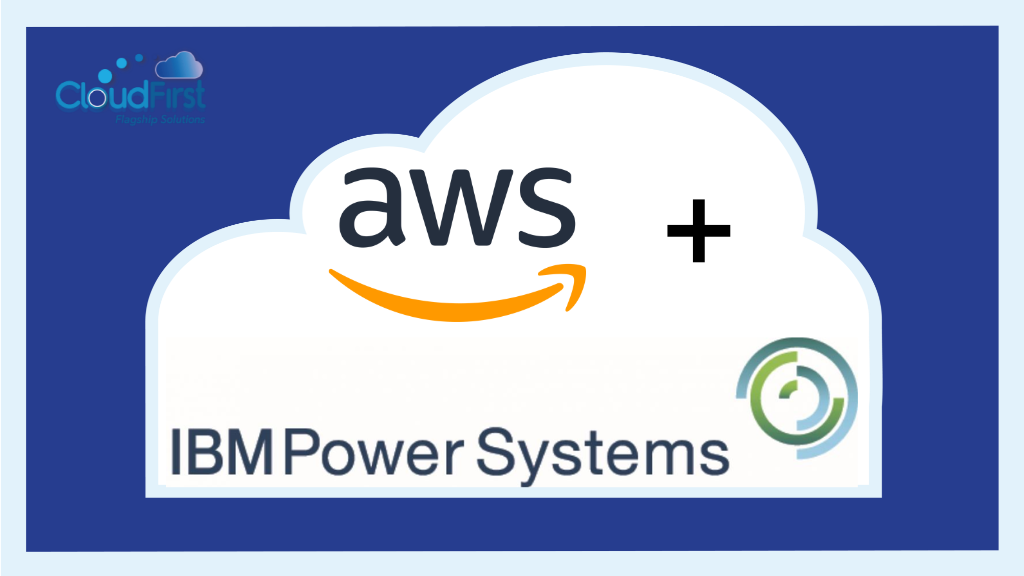Are you trying to figure out how to run IBM Power Systems on Amazon Web Services (AWS)?
You’ve seen the power of the cloud for yourself, and you’ve already migrated most of your IT to AWS. The last holdout is your IBM Power servers. You want to lift and shift those to the cloud next, and you also need to make sure they work flawlessly with your AWS infrastructure.
While AWS doesn’t support IBM i or AIX, you can seamlessly integrate IBM Power with the rest of your cloud by taking advantage of Direct Connect. And with a better understanding of how everything communicates with each other, you’ll make the most of your IBM cloud environment and AWS.
Why do you need Direct Connect?

There are plenty of benefits to cloud migration, but companies that rely on IBM Power often struggle to migrate their current technology to public clouds like AWS. And since AWS doesn’t natively support Power Systems, that makes Direct Connect the missing link—literally.
Basically, Direct Connect is a big private pipeline that goes from one cloud to another. It provides a secure, low-latency, high-bandwidth connection for multi-cloud environments.
IBM Cloud Direct Connect enables two clouds to operate seamlessly as one. While these two clouds will technically continue working independently, the user experience is essentially like using one cloud environment. It’s the most straightforward way to create multi-cloud environments.
These connections are also more reliable and secure than alternatives like a virtual private network (VPN), giving you confidence that your sensitive data is safe as it travels between IBM Power and AWS. With Direct Connect, no data travels over the open internet like it does with a VPN.
The PCMag review of AWS also highlights why you’ll want to use Power with AWS. Both have multiple benefits that companies can enjoy simultaneously, but they’d have to do so separately if it weren’t for Direct Connect. PCMag lauds AWS for having “rock-solid security” and “an impressive level of service.”
If you’re already an AWS customer, you can probably relate. The one frustration that remains is what to do with your on-premises IBM i or AIX servers.
Direct Connect is the solution. It’s the closest thing to running Power Systems on AWS, and it lets you create a fully integrated multi-cloud environment that provides:
- Fast and secure data sharing
- Seamless cloud backups
- Simplified multi-cloud management
- Application and systems modernization
Integrating IBM Power cloud environments with your IT on AWS
It’s no longer IBM Cloud vs. AWS. Direct Connect is the link, making it easy to run IBM i or IBM AIX with AWS. But what does proper integration between the two actually look like?
Here’s how to make the merging of the two simpler to navigate and understand.
Considerations when running IBM Power on AWS
If you’re ready to commit to running AWS and IBM Power together, you’ll want to focus on workload compatibility, security, and access to support.
Workload compatibility and optimization must be considered when operating in a multi-cloud environment like AWS with IBM. You can use tools provided by IBM, AWS, and CloudFirst to track performance and costs. Once you have that data, you’ll be able to spot opportunities to reallocate resources in order to optimize usage and make sure your money is working for you.
Security will always be a consideration when using public clouds. AWS, CloudFirst, and Direct Connect all have features to ensure an ironclad defense, including firewalls, attack surface reduction, and advanced encryption.
Finally, as you integrate AWS and IBM Power, you’ll want to enlist the help of professionals to ensure your data has a safe and smooth voyage. The goal is to optimize a multi-cloud environment with AWS and Power. A managed services provider like CloudFirst can help you with everything from data migration to ongoing management of your various workloads.
Specific benefits and solutions for businesses
Once you’re up and running with Direct Connect, you can finally reap the many benefits of operating on multiple clouds. This setup combines everything you love about AWS with everything familiar and consistent about IBM Power.
The most notable benefit of using a multi-cloud environment is how much flexibility it gives your company to grow. This type of cloud setup opens the door to significant expansion and innovation without being hindered by IT restrictions. A service-oriented cloud architecture provides modularity and composability that frees your admins and developers from dependency hell.
Gaining this level of flexibility and agility is crucial for companies of all sizes that want to continue on an upward trajectory, and it is an important part of any business continuity plan.
HP writes that hybrid clouds are an excellent investment, even for small businesses, since they cost much less than private clouds. At this point, it’s not even worth it for most companies—except the very largest—to build their own data centers.
Merging AWS and Power into a hybrid cloud environment also enables you to take advantage of AWS’s extensive suite of services without sacrificing the critical workloads already operating on your Power Systems. The end result is significant savings on IT costs.
AWS Direct Connect and your IBM Power tech stack

One of the many reasons companies still use IBM Power is that the applications and services they depend on only run on IBM. With IBM Power on AWS, you’ll still have full access to these systems—now with the added benefits of AWS.
IBM Db2 on AWS
Db2 is a comprehensive database management system that runs on IBM Power Systems and provides a robust platform to analyze data. Fortunately, AWS offers solutions that, when IBM and AWS are communicating through Direct Connect, allow you to still reap the benefits of using IBM Db2 on AWS.
AWS users can set up an Amazon Relational Database Service (RDS) deployment of Db2 and synchronize it with backup servers and other databases running on an IBM Power hybrid cloud like CloudFirst has to offer. The direct connection between the two clouds means that applications and databases can pass high data volumes between them, securely and without lag.
IBM MQ on AWS
IBM MQ is messaging middleware that allows applications to exchange data without security or scalability concerns. Like it does with Db2, Direct Connect enables you to continue using this system as you see fit. Running IBM MQ on AWS frees up much of your IT infrastructure budget through enhanced scalability.
Users can leverage the features of a hybrid cloud for even more secure MQ deployments. However, it’s vital that you plan your deployments carefully. If you want the deployment model you’re using to fit your needs, you’ll treat a single-instance MQ much differently than a multi-instance setup.
In a single-instance setup, there’s less concern with muddled deployments, since you’re operating out of one application or product. Multi-instance deployments, however, might require you to make tweaks based on who, or which department, is using a given instance.
Larger organizations often see the most benefit from multi-instance deployments with IBM MQ on AWS, but they’ll want to adjust each instance to ensure everything is working as intended.
IBM Cloud Paks on AWS
IBM Cloud Paks are conveniently packaged application suites for IBM users. For example, their Cloud Pak for Applications includes MQ and Db2, while the IBM Cloud Pak for Data on AWS focuses on services that help collect and analyze essential data.
It’s highly convenient, with IBM touting that 60% of users see a “reduction in processing time by leveraging hyper automation to boost productivity.”
The best solution for operating any IBM Cloud Pak on AWS is understanding your business’s technical requirements. If you’re deciding between Cloud Pak options, determine which one best suits your needs; this is another opportunity to leverage professional services to ensure operations run smoothly.
Everything you love about IBM Power and AWS—together
With the power of Direct Connect, there’s no more tug-of-war between IBM Power Systems and AWS; they work together in perfect harmony to get you consistent results, enhanced scalability, and unparalleled security.
The easiest option is to use CloudFirst to merge these two IT powerhouses and get the best of the best without sacrificing the rest.
Ready for a deep dive? Download our free Direct Connect white paper to learn everything you need to know about multi-cloud computing for IBM i and AIX.

